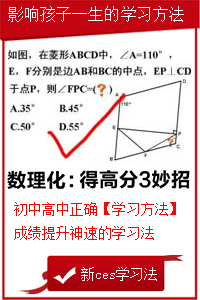刻意练习的程度是决定一个人能否成为顶级高手的关键。用这个理论可以很好地解释,为什么英语爱好者那么多,但真正能成为英语高手的却凤毛麟角?下面小编就和大家分享通过“刻意练习”提升托福阅读能力,来欣赏一下吧。
通过“刻意练习”提升托福阅读能力
但仅仅依靠足够的阅读量积累就能让你达到接近母语的阅读水平吗?答案并不是。因为如果真是这样的话,那么假以时日,每个人都能成为阅读大神了。实际上,有些人虽然在国外生活学习了很多年,英文阅读量也不低,但还是没能达到流畅阅读英文材料的程度。为什么?
回答这个问题之前我们要了解一个概念,它叫“刻意练习”(Deliberate Practice)
“刻意练习”这个概念最早由心理学家 K.Anders Ericsson 提出(同时他也是“10000小时定律”的作者)。“刻意练习”的核心假设是,专家级水平是逐渐地练出来的,而有效进步的关键在于找到一系列的小任务让受训者按顺序完成。这些小任务必须是受训者正好不会做,但是又正好可以学习掌握的。完成这种练习要求受训者思想高度集中,这就与那些例行公事或者带娱乐色彩的练习完全不同。
“刻意练习”的概念在日常生活中其实有很多应用。拿体育运动来说,研究人员考察花样滑冰运动员的训练时发现,在同样的练习时间内,普通的运动员更喜欢练自己早已掌握了的动作,而顶尖运动员则更多地练习各种高难度的自己并不习惯的动作。普通的爱好者打高尔夫球纯粹是为了享受打球的过程,而职业的高尔夫选手则需要不断练习在各种极端不舒服的位置打不好打的球。
而刻意练习的程度是决定一个人能否成为顶级高手的关键。用这个理论可以很好地解释,为什么英语爱好者那么多,但真正能成为英语高手的却凤毛麟角?
普通的英语爱好者享受的是英语带来乐趣的过程,比如闲暇时看看美剧,读一读原版书娱乐一下,没事跟老外吹吹水,浏览一下英语新闻,整个过程轻松愉快。但顶级高手的训练过程却毫无乐趣可言,他们会针对一个个点进行大量有挑战性的训练,比如为了练发音练到嘴巴疼,一篇议论文会针对不同论点反反复复练习修改上好几遍,做那些夹杂着各种口音且语速超快的听力训练——相信我,这个过程会让你吃不好饭睡不好觉,一点也不好玩。但它却是决定你能否取得有效进步的关键。
回到阅读能力的话题上来,由这个理论得到启发,我们会发现除了阅读量之外,制约阅读能力提升的另外一个重要因素是:刻意阅读训练的程度。
打个比方,假如你现在的水平可以看懂各种简单的原版书,为了提升阅读能力,你应该选择那些对你而言有挑战性的读物,比如难度大一点的外刊,这样阅读能力才能不断提升,而不能仅仅停留在现有的水平。事实上,从小学到大学,我们接触到的阅读材料难度也一直在不断提升,从小学的句子短文到高中大学复杂的文学作品,而这也是刻意阅读练习的一个体现。
怎样进行刻意阅读练习?
进行刻意阅读练习有两个关键,一个是阅读材料的选取,另外一个是阅读理解技能的培养。
先说阅读材料。
心理学家把人的知识和技能分为三个圆形区域:最内一层是“舒适区”,里面是我们已经熟练掌握的各种技能,长期待在这个区域很难取得进步;最外一层是“恐慌区”,这个区域里面的技能难度远超我们现有能力,会让人产生挫折,焦虑等情绪,也会对进步产生阻碍。最中间的则是“学习区”,只有在学习区里面练习,一个人才可能进步。
关于阅读材料的选取我们可以参考“学习区”的概念:即:选取那些对你有难度但又可以通过一定练习驾驭的材料。比如你觉得雅思的阅读有挑战性,那么可以去找雅思阅读的题源文章作为训练材料,等到能够驾驭雅思阅读文章,再去找难度更高的文章进行训练。
对于不同的人来说,适合自己的“学习区”材料并不相同,这个需要学习者本身去尝试挑选。但有一个基本的建议是:阅读训练材料以新闻报刊为主。为什么?因为报刊文章篇幅较短,而且信息量大,逻辑性强,非常有利于培养理解能力。而理解能力的培养,至关重要。
你可能会注意到,试卷上的阅读板块叫“阅读理解”(reading comprehension),而不叫“阅读”,这其实揭示了一个道理:阅读过程是由两个部分组成的,一个叫“阅读(信息输入)”,一个叫“理解(信息处理)”。而很多人往往只注意到了“阅读”,并没有去训练“理解”能力。
网上关于快速阅读的技巧多如牛毛,人们发明了各种各样稀奇古怪的技巧来让你“读”得更快,比如阅读时控制光线和环境,用手指或者笔辅助视线定位。但相信我,这些并没有什么用,它们关注的只是“信息输入速度”的问题,而“理解过程”如果跟不上,读得再快也毫无用处。最关键的,是要提高“信息处理”的能力。
决定阅读能力的,并不是“读得多快”,而是“理解得多快”。
所以刻意阅读练习的关键其实是培养理解能力。一般来说,制约阅读理解能力主要有以下几个因素:
1.词汇量
2.语法句法基础
3.背景知识
词汇量是阅读理解的基石。请不要相信那些“几千词汇量就够用”的鬼话,那是欧美国家文盲水平,读不懂外刊和原版书的。受过良好教育的英文母语人士词汇量一般都在20000以上,如果你要像他们一样流畅读懂各种外刊,词汇量最好也不要低于这个值。关于词汇量提升,最好的方法还是通过阅读。
语法句法基础对阅读理解的准确率也有很大影响,最常见的是各种长难句,如果你句法基础不好的话,理解起来会非常吃力。解决的方法也很简单,哪里基础不好就补哪里——语法句法知识也就那么多,一本教材认真看完也就几个星期的事情,但对理解能力的提升却是显而易见的。
背景知识这一点经常被人忽略,但它对理解文章起到举足轻重的作用。举个例子,如果你对英国的政党制度没有一定的了解,那么经济学人上的这篇文章关于英国工党选举的那些事估计会看不懂,尽管你知道每一个单词每一个短语的意思。
对于背景知识,建议在读文章的时候慢慢积累,不懂的就上网查,多读读像《经济学人》这些的外刊,文章信息量非常大,往往涉及到很多背景知识,如果能坚持读下来并弄懂每一篇文章,你的收获将会非常大。
托福阅读背景素材之世界杯的历史文化
A group of visionary French football administrators, led in the 1920s by the innovative Jules Rimet, are credited with the original idea of bringing the world's strongest national football teams together to compete for the title of World Champions. The original gold trophy bore Jules Rimet's name and was contested three times in the 1930s, before the Second World War put a 12-year stop to the competition.
When it resumed, the FIFA World Cup rapidly advanced to its undisputed status as the greatest single sporting event of the modern world. Held since 1958 alternately in Europe and the Americas, the World Cup broke new ground with the Executive Committee's decision in May 1996 to select Korea and Japan as co-hosts for the 2002 edition.
Since 1930, the 16 tournaments have seen only seven different winners. However, the FIFA World Cup has also been punctuated by dramatic upsets that have helped create footballing history - the United States defeating England in 1950, North Korea's defeat of Italy in 1966, Cameroon's emergence in the 1980s and their opening match defeat of the Argentinean cup-holders in 1990....
Today, the FIFA World Cup holds the entire global public under its spell. An accumulated audience of over 37 billion people watched the France 98 tournament, including approximately 1.3 billion for the final alone, while over 2.7 million people flocked to watch the 64 matches in the French stadium.
After all these years and so many changes, however, the main focus of the FIFA World Cup remains the same - the glistening golden trophy, which is the embodiment of every footballer's ambition.
托福阅读真题原题+题目
The first birds appeared during late Jurassic times. These birds are known from four very good skeletons, two incomplete skeletons, and an isolated feather, all from the Solnhofen limestone of Bavaria, Germany. This fine-grained rock, which is extensively quarried for lithographic stone, was evidently deposited in a shallow coral lagoon of a tropical sea, and flying vertebrates occasionally fell into the water and were buried by the fine limy mud, to be preserved with remarkable detail. In this way, the late Jurassic bird skeletons, which have been named Archaeopteryx, were fossilized. And not only were the bones preserved in these skeletons, but also were imprints of the feathers. If the indications of feathers had not been preserved in association with Archaeopteryx, it is likely that these fossils would have been classified among the dinosaurs, for they show numerous theropod characteristics. Archaeopteryx were animals about the size of a crow, with an archeosaurian type of skull, a long neck, a compact body balanced on a pair of strong hind limbs, and a long tail. The forelimbs were enlarged and obviously functioned as wings.
Modern birds, who are the descendants of these early birds, are highly organized animals, with a constant body temperature and a very high rate of metabolism. In addition, they are remarkable for having evolved extraordinarily complex behavior patterns such as those of nesting and song, and the habit among many species of making long migrations from one continent to another and back each year.
Most birds also have very strong legs, which allow them to run or walk on the ground as well as to fly in the air. Indeed, some of the waterbirds, such as ducks and geese, have the distinction of being able to move around proficiently in the water, on land, and in the air, a range in natural locomotor ability that has never been attained by any other vertebrate.
1. According to the author, all of the following evidence relating to the first birds was found EXCEPT
(A) nesting materials
(B) four skeletons in good condition
(C) two fragmented skeletons
(D) a single feather
2. The word preserved in line 8 is closest in meaning to
(A) confused with others
(B) gradually weakened
(C) protected from destruction
(D) lost permanently
3. It can be inferred from the passage that the Archaeopteryx were classified as birds on the basis
of
(A) imprints of bones
(B) imprints of feathers
(C) the neck structure
(D) skeletons
4. The word they in line 10 refers to
(A) indications
(B) fossils
(C) dinosaurs
(D) characteristics
5. Why does the author mention a crow in line 11?
(A) to indicate the size of Archaeopteryx
(B) To specify the age of the Archaeopteryx fossils
(C) To explain the evolutionary history of Archaeopteryx
(D) To demonstrate the superiority of the theropod to Archaeopteryx
6. It can be inferred from the passage that theropods were
(A) dinosaurs
(B) birds
(C) Archaeopteryx
(D) crows
7. The word constant in line 16 is closest in meaning to
(A) comfortable
(B) combined
(C) consistent
(D) complementary
8. The author mentions all of the following as examples of complex behavior patterns evolved by
birds EXCEPT
(A) migrating
(B) nesting
(C) singing
(D) running
9. The word attained in line 23 is closest in meaning to
(A) required
(B) achieved
(C) observed
(D) merited
PASSAGE 59 ACBBA ACDB
英语阅读相关文章:
★ 英语阅读
★ 高一英语阅读理解及答案
★ 如何快速阅读英语文章
★ 2020年中考英语阅读
★ 考研英语微观、宏观阅读技巧
★ 2018年6月英语六级阅读理解-4附翻译
★ 高一英语短篇阅读理解试题
★ 高考英语阅读理解长难句的处理技巧
★ 英语满分中考作文10篇合集
★ 精选高三英语复习计划三篇
通过刻意练习提升托福阅读能力
上一篇:托福阅读三步解题技巧
下一篇:巧用反义推理提升托福阅读速度






